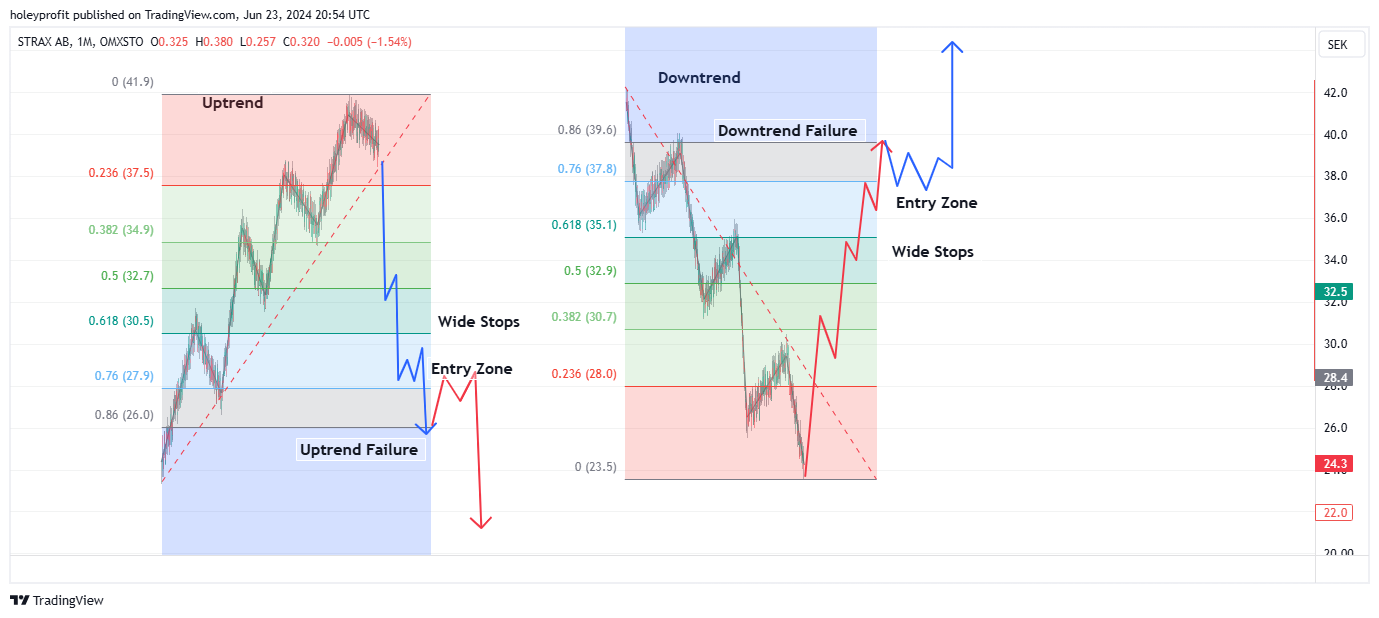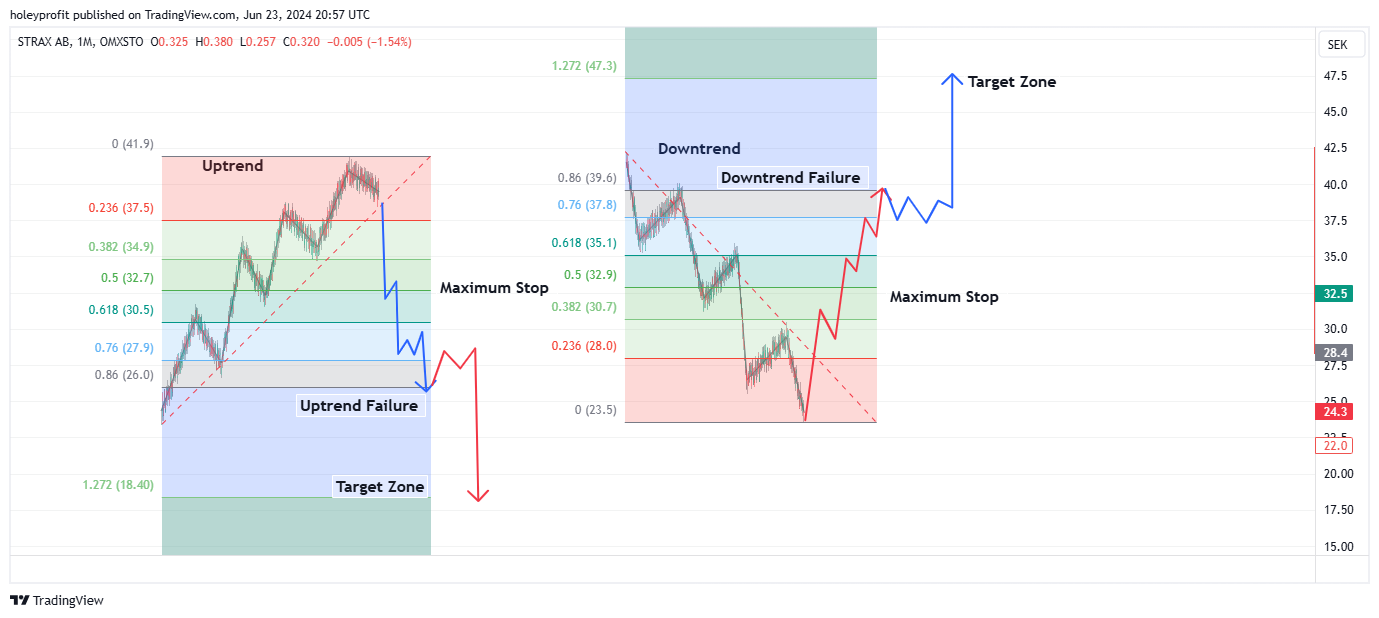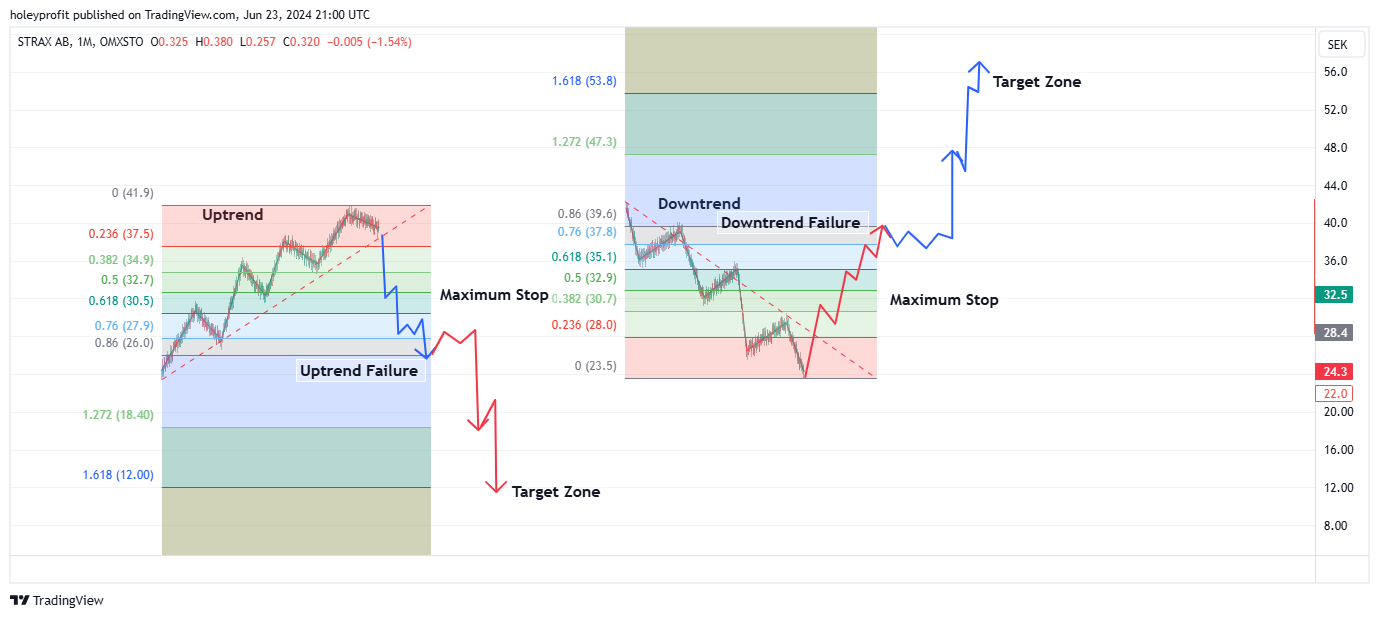This is part of a series of strategy posts.
Once all strategy posts are up, they will be linked together. Initially there will be placeholders for links - Marked “(Link)”. This is because all posts need to be published to be able to interlink them. Please check back later for complete interlinking.
The original series of posts will contain 15 strategies. All of them time tested and ones I’ve personally used to make a living in markets for over 10 years. These will all be free. Multiple additional posts will be added for paid members. Discussing advanced strategy, nuances and covering the common questions we’d expect about the strats.
You can join as a paid member for only $15.
Strategy Name
76 Failure Continuation Strategy
Strategy Type:
-Trend continuation
Strategy Premise Overview:
-This strategy capitalizes on the failure of the 76% retracement reversal setup. The 76% setup is a strong strategy for providing optimal entries into retracements and the failure of it often tells us something important. This is a counter strategy that bets on continuation of momentum.
-The strategy looks to enter on a retest of the 76% level after the 86% level has been hit, targeting an extended move in the direction of the original trend.
-This can also be used as a means to spot the failure of a trend and early stages of reversal. Useful both for trading and trailing stops.
Conditions for Use:
- Best used in trending markets where there is a clear and strong directional move.
-Avoid using in ranging or choppy markets where the trend direction is uncertain.
Planning Entries:
-Start by identifying a significant impulse leg in the direction of the prevailing trend and draw the Fibonacci retracement levels from the start to the end of this impulse leg.
-Set an alert on the 86% retracement.
-If the 86% Fibonacci retracement level is hit, this signals the potential failure of the 76% reversal strategy.
-Set an alert at the 76% Fibonacci level to notify you of the retest opportunity.
-Place a pending limit order at the 76% Fibonacci level for re-entry into the original trend.
Planning Stops:
-Tight Stop: There can be times this trade comes as a near perfect 76% retest and rejection. It can be viable to have really tight stops in this setup using additional price action signals. Is prone to higher loss rates but pays very high RR. Suitable for active day trading where you can get in and out of multiple small trades looking for one big one.
-Wide Stop: A stop less suspectable to spike outs is behind the 61% retracement. This improves win rate at the cost of lower RR. It’s far more suitable for a passive/semi passive style of trading where you just want to set entry/exit levels and let the trade do the work.
-Maximum Stop: This setup has entirely failed if the 50% fib is broken. The bet of this setup is essentially that now the lower fibs have broken they’ll hold retests and if we’re breaking over the 50% fib that clearly isn’t working.
Planning Targets:
-The low hanging fruit target of this trade before there are big pullback risks is the 1,27 fib. After some choppy action around the 61 - 86% zone the breakout is usually clean and strong to at least the 1.27. This is a good target if passively managing trades.
-If you can track the action and actively trail stops then trail them tight using recent price action when 1.27 hits and the following target area is the 1.61. Pull stops tight again when near the 1.61 since this is another major reversal/pullback level.
-No major pullbacks is very rare but if we break the 1.61 we can go into a real run away trend, with minimum targets being the following fibs. If you get a trailing stop trade that runs, repeat the same process of trailing stops tight using recent structure and, especially as we hit resistance zones
.
Typical Win Path:
-After the 86% Fibonacci retracement level is hit, we usually see a very strong counter trend move.
-Often the overall move is going to be as simple as price retests the 76% fib, rejects off it and continues the previous move. However, the actual action inside of this is often choppy (And of course we get varying degrees of spike outs of the 76%)
- The rebreaking of the 86% fib (Note: sometimes we can bounce off this multiple times first) often leads to a strong breakout. At this point we can move stop losses to just above the 76% fib and wait to see if the breakout succeeds. This can also be a spot to take new trades using momentum based strategies.
Typical Lose Path:
-Sometimes when this shallow retest and continuation strategy fails, price goes on to act the same as it does in the setup the 76 Reversal Strategy looks for. I consider these to be 76% reversals that just had bigger stop hunts and use the same rules to look to follow the momentum and trail stops behind broken fibs.
-The two strategies for making decisions around the 76 and 86% retracement levels often perform well. They compliment each other to make decision making easy (Even while having to make them after aggressive moves), provide plans for both sides and quite often one or the other will work. However, sometimes price can violate this with the concept failing on both sides.
-When we are seeing multiple failures of the 76/86 it’s time to stop trading these strategies in this swing. Wait for a new swing to be established and try it again. Usually when this is happening the market is ranging, anyway, while would only predict more losses for a breakout strategy.
Why Strategy is Expected to be Successful:
-It’s a subtle thing, but if you look at lots of big retracements in impulse legs you’ll find the ones that were successful in trend continuation were reversals from the 76% retracement zone and most of the time when 86% we will ultimately break 100% (Make a new high/low in the trend).
-This strategy looks to trade a strong breakout move to at least the 1.27% fib. A high RR move with the potential for double to triple profits in the rarer occasions where there’s no pullbacks to trail out trailing stops.
-At it’s core this is a momentum strategy aiming to take advantage of the rush of momentum we often get into a breakout. Where price chops for a while but then the trend starts to get really wild. Often this section will quickly correct (After hitting 1.27) but it’s very common to see a lot of momentum initially if highs/lows are broken.
Known Risks and Weaknesses:
-The strategy relies heavily on the 86% retracement level being a clear signal of trend continuation, which won’t always be the case. It will often be the case, but in the times it is not the case it will almost invariably flip your bias at what turns out to be exactly where the market turned.
-86% to 86% swings. If a market is going down and it breaks an 86% fib, I think it’s going lower. If it then went up and broke the 86% of the drop, I’d think it was going higher. These rules serve me well most of the time, but suffer in times these types of strings of false signals appear (Usually as a range develops).
-In what will become very big trades, there’s more of a tendency for false signals in this. Moves that will end up producing huge reversals and the 86% move was just the final spike out. Since the most common reaction for an 86% is a correction, when it reverses off of there you’ll think this is setting up a continuation trade right before a big reversal.
Trade Execution Plans
Bullish Execution Plan for the 76 Failure Continuation Strategy:
Market Analysis:
Identify a clear uptrend with higher highs and higher lows.
Use higher timeframes to confirm the trend direction.
Draw Fibonacci Levels:
Identify the most recent significant swing low to swing high.
Draw Fibonacci retracement levels from the swing low to the swing high
.
Set Failure Alert:
Set an alert on 86% Fibonacci retracement level. If this hits the strategy becomes active. The 76% retracement has failed to reverse the market.
Set Alerts and Orders:
Set an alert at the 76% Fibonacci retracement level.
Place a pending limit buy order at the 76% Fibonacci retracement level for a re-entry into the uptrend.
Place Stop Loss:
Set a tight stop loss slightly below the 76% Fibonacci level.
Alternatively, place a wider stop loss below the 61% Fibonacci retracement level or even the 50% Fibonacci level for maximum stops.
Manage Trade:
Be prepared for potential retests of the 76% level and manage the trade accordingly. Do not trail stops to even too quickly. Stops can go to above the 76% fib once 86% is broken.
Set Targets:
The initial target is the 127% Fibonacci extension level.
Consider using trailing stops and aiming for extended targets at 1.61, 2.20, and beyond.
Bearish Execution Plan for the 76 Failure Continuation Strategy:
Market Analysis:
Identify a clear downtrend with lower lows and lower highs.
Use higher timeframes to confirm the trend direction.
Draw Fibonacci Levels:
Identify the most recent significant swing high to swing low.
Draw Fibonacci retracement levels from the swing high to the swing low.
Set Failure Alert:
Set an alert on 86% Fibonacci retracement level. If this hits the strategy becomes active. The 76% retracement has failed to reverse the market.
Set Alerts and Orders:
Set an alert at the 76% Fibonacci retracement level.
Place a pending limit sell order at the 76% Fibonacci retracement level for a re-entry into the downtrend.
Place Stop Loss:
Set a tight stop loss slightly above the 76% Fibonacci level.
Alternatively, place a wider stop loss above the 61% Fibonacci retracement level or even the 50% Fibonacci level for maximum stops.
Manage Trade:
. Be prepared for potential retests of the 76% level and manage the trade accordingly. Do not trail stops to even too quickly. Stops can go to above the 76% fib once 86% is broken.
Set Targets:
The initial target is the 127% Fibonacci extension level.
Consider using trailing stops and aiming for extended targets at 1.61, 2.20, and beyond.

























